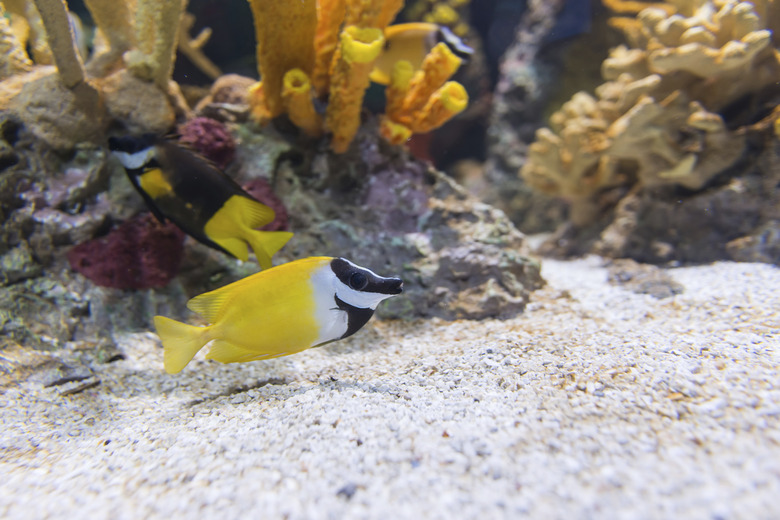The Use Of Epsom Salts In Fish Aquariums
We may receive a commission on purchases made from links.
Disclosure: At Cuteness, we are committed to being the go-to resource for pet owners and animal lovers. We only recommend products we think our audience will love. If you purchase something by clicking on one of these links, we may receive a small commission of the sale and the retailer might receive some data for accounting purposes.
Epsom salt is the common name for the compound magnesium sulphate — a chemical containing magnesium, sulfate, and oxygen. Despite its name, Epsom salt doesn't contain sodium. Magnesium is a mineral that is important for many systems of the human body — especially the nerves and muscles. It's also beneficial to aquarium fish suffering from maladies such as dropsy, constipation, and swim bladder disorder. Epsom salt may be added to fresh water fish tanks to alter the chemistry of the water.
Increasing water hardness
Increasing water hardness
Epsom salt may be used to increase water hardness in freshwater aquariums. Harder water contains more dissolved magnesium and calcium than soft water. Some species of fish require hard water, while others require soft. The degree of hardness impacts the tank's pH. Hard water is more alkaline, soft water is more acidic. Water hardness is expressed in the amount of calcium carbonate (CaCO3) it contains. According to Aquatic Community, "adding 1 milliliter of [epsom salt] per 10 liters of water will increase the permanent hardness by roughly 70 mg/L CaCO3." Determine the optimum pH and water hardness levels for the type of fish in your aquarium before altering your tank's chemistry. Abrupt shifts in pH levels can stress, even kill fish. Avoid a change in pH greater than 0.3 in a 24-hour period.
Epsom salt for constipation in bettas
Epsom salt for constipation in bettas
Constipation is a common condition suffered by many types of fish, including bettas. Symptoms include belly bloat and loss of appetite. Constipation is usually caused by overfeeding or feeding a low-fiber diet. Stop feeding a fish with this condition for 24 to 48 hours. If you don't see improvement, offer the fish tiny pieces of the inside of one fresh or frozen pea — canned peas are too salty. If the fish shows no improvement, consider giving him an Epsom salt bath, which acts as a muscle relaxant. To give your fish an Epsom salt bath, pour half of the tank's water into a clean container. Add 1 tablespoon of Epsom salt for every 1 gallon of water. Have the fish swim in the solution for 15 to 30 minutes. Remove the fish promptly and return him to his aquarium if he appears stressed or relieves himself.
Epsom salt for treating dropsy
Epsom salt for treating dropsy
Dropsy is a potentially fatal condition in which the kidneys of a fish fail, leading to fluid retention. A fish experiencing dropsy has a bloated abdomen and raised scales. Epsom salt may be used as part of dropsy treatment by isolating the sick fish in a separate "hospital" tank, then adding Epsom salt at a rate of 1/8 teaspoon for every 5 gallons of water. The Epsom salt will relieve swelling. She also suggests feeding the fish a special diet containing antibiotics. Never use aquarium salt, or any other type of sodium, to treat a fish with dropsy: It may worsen the condition.
Epsom salt for swim bladder disorder in goldfish
Epsom salt for swim bladder disorder in goldfish
Swim bladder disorder can strike all freshwater fish, but goldfish are especially prone to develop it. Fish with this condition have difficulty swimming upright because the swim bladder, which is normally filled with air, is compromised. Swim bladder disorder may be caused by gulping too much air, impacted eggs, infection, or constipation. Treat swim bladder disorder by skipping feedings for two to three days, then feeding a de-skinned pea. If that doesn't help, increase the tank's water temperature to between 78 and 80 degrees Fahrenheit and add Epsom salt at a rate of 1/8 teaspoon per 5 gallons of water.
Finding Epsom salt for your tank
Finding Epsom salt for your tank
You can purchase Epsom salt from a wide variety of retailers. Amazon has numerous options, such as Health Smart's Natural Epson Salt, which quickly dissolves and comes in a grain size. There's also Epsoak Epsom Salt, which comes in a 2-pound bag and dissolves quickly, is cruelty-free, and made in the USA. Before purchasing any Epsom salt, just give a quick call to your veterinarian or local pet store where you bought your fish to make sure that you're getting the right product. Make sure that when you're purchasing salt you don't confuse Epsom salt with aquarium salt, which can have an adverse effect on your fish.
While you're shopping, you could always look into buying a new tank just in case yours isn't big enough. For instance, the Tetra Aquarium 20 Gallon Fish Tank Kit includes lighting and décor and will be perfect for your fish.
